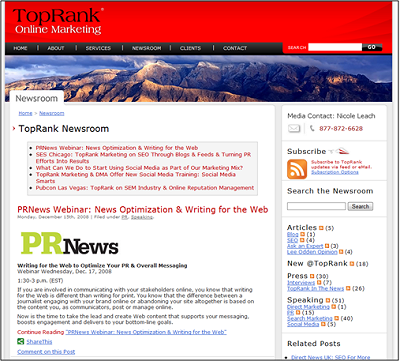 Most web sites with active media relations programs host an online newsroom. Analysts, journalists and even some bloggers find newsrooms a useful resource for finding past media coverage, press releases, image assets, executive bios, company history, webinars, white papers, case studies and other information helpful for researching stories.
Most web sites with active media relations programs host an online newsroom. Analysts, journalists and even some bloggers find newsrooms a useful resource for finding past media coverage, press releases, image assets, executive bios, company history, webinars, white papers, case studies and other information helpful for researching stories.
Any content that is published to the web can be optimzed for search and that includes online newsrooms. We prefer to implement online newsrooms with blog software, because of the content management features and inherent search engine benefifts. Automatic RSS feed creation is also a benefit.
Newsrooms should offer easy to find contact information as well as a content categorization scheme that considers keywords as part of the taxonomy. Organizing press releases by date isn’t very useful for searchers. Archiving press releases and other content within the newsroom by categories, chronologically as well as by keyword tag (as in folksonomy, not meta keyword tag) can be quite useful to readers as well as search engines.

SEO and user friendly features of an online newsroom include:
- Titles & categories optimized for keywords
- Chronological press release archives
- Site search that saves user queries for later analysis
- Share/Save bookmarks
- Subscribe RSS Feed
- Optimized newsroom content: press releases, past media coverage, events, case studies, white papers, archived webinars, images, videos and audio
- Cross link using keywords to related pages on main web site
Optimizing an online newsroom is similar to optimizing other types of web content. It’s important to consider the audience whether it’s members of the media, industry analysts or consumers and make sure you’re publishing content that meets their needs. Here’s a newsroom SEO checklist assuming a content management system or blog is being used to host and manage newsroom content:
- Research a keyword glossary
- Keyword optimize title tags (dynamic AND hard coded)
- Keywords optimize category names
- Use keywords in document titles, directory names, file names
- Add social links: make it easy fo readers to bookmark and share newsroom content
- Include an optimized RSS feed to facilitate syndication and ease of discoverability within RSS search engines like Google Blog Search
- Optimize digital assets: images, video and audio as well as other file formats: MS Office docs & PDF
Publishing content to a newsroom typically follows a process. To realize the SEO benefits in the most efficient way, make sure those responsible for adding content are trained on basic SEO and include keyword optimization as part of the newsroom update process.
Besides keyword optimization, it will be important to attract links to the newsroom from other web sites. If the newsroom is managed by blog software, then it can be submitted to a list of blog directories. It can be linked to within press releases distributed through wire services and included in links published on social web sites. Interesting and useful content that has the best exposure will attract the most links that matter.
Besides using blog software for online newsrooms, many content management systems will support newsroom functionality. You can also purchase hosted newsroom services through companies like: TEKgroup International, NewsCactus, iPressroom, PRWeb or a marketwire social media newsroom.
This is post #7 in a series of ten about the intersection of public relations and search engine optimization, “Top Ten SEO Tips for PR“. Our next post is “Link Building Fundamentals for News Content“.


